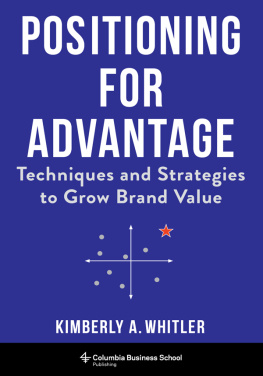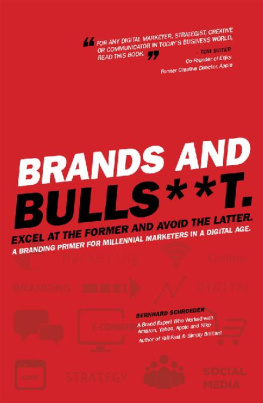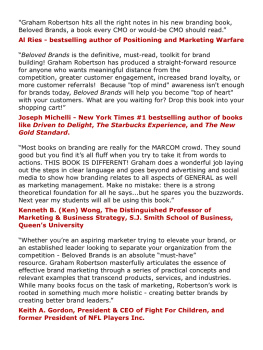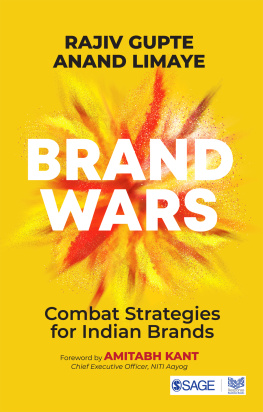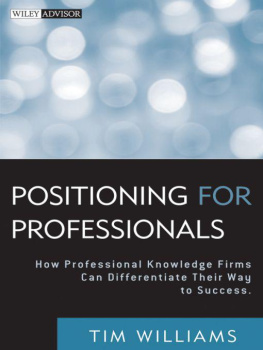Table of Contents
Positioning for Advantage
Columbia University Press
Publishers Since 1893
New YorkChichester, West Sussex
cup.columbia.edu
Copyright 2021 Columbia University Press
All rights reserved
EISBN 978-0-231-54811-3
Library of Congress Cataloging-in-Publication Data
Names: Whitler, Kimberly A., author.
Title: Positioning for advantage: techniques and strategies to
grow brand value / Kimberly A. Whitler.
Description: New York: Columbia University Press, [2021] |
Includes bibliographical references and index.
Identifiers: LCCN 2020056646 (print) | LCCN 2020056647 (ebook) |
ISBN 9780231189002 (hardback; alk. paper) | ISBN 9780231548113 (ebook)
Subjects: LCSH: Brand name productsManagement. | Branding (Marketing) |
Product management.
Classification: LCC HD69.B7 W45 2021 (print) | LCC HD69.B7 (ebook) |
DDC 658.8/27dc23
LC record available at https://lccn.loc.gov/2020056646
LC ebook record available at https://lccn.loc.gov/2020056647
A Columbia University Press E-book.
CUP would be pleased to hear about your reading experience with this e-book at .
Cover design: Noah Arlow
Contents
1
The Marketing Impact Framework
2
The Positioning Concept
3
The Brand Essence Statement
4
Strategy Map Types
5
The Strategic Marketing Plan
6
The Creative Brief
7
The Marketing Technology Blueprint
8
Key Opinion Leader and Influencer Mapping
9
Brand Measurement Methods
10
Activating the Tools through Practice and Implementation
I have been beyond fortunate to have had countless colleagues and advisers who influenced my professional and intellectual growth throughout my life. Although it is impossible to acknowledge the hundreds of executives who have been interviewed, the number of faculty and professional colleagues who have fostered my growth, and the innumerable students with whom I have had the pleasure to work, I want to recognize a few consequential individuals who have helped bring this book to life.
First, thanks go to members of the University of Virginia Darden Business School community who have been deeply involved, including a number of students who have conducted research, provided input, and read excerpts to ensure clarity: Ellen Regan, Stephen Mann, Adrian Viesca Trevino, Kirstin DeCecca, Mark Pohl, Kate Maxwell, Kyle Wyper, and Wilkerson Anthony. Sarah Young, an undergraduate research assistant at UVA, has been especially helpful conducting research, reviewing and checking figures, references, and images. I have worked with Sarah for nearly two years and she is an extraordinary talent.
Second, I thank the friends, colleagues, CMOs, and CEOs who have provided insight along the way. Although too numerous to cite, there are certain individuals who repeatedly shared their unique insight: Scott Brinker, Marsha Collier, Steven Cook, Christine DeYoung, Caren Fleit, Brian Hansberry, Bob Huth, Antonio Lucio, Tamara McCleary, Gene Morphis, Drew Neisser, Scott Vaughan, Greg Welch, Dan White, and FD Wilder.
Third, I thank the individuals who were formative early in my careerwhose lessons still matter: Jeff Vicek (the absolute best economics professor), Rick Thompson (the perfect summer intern and first boss), and Deb Henretta (the best early-career mentor one could want). I was fortunate to start at Procter and Gamble and to learn what strategic growth engineering was all about from dozens of excellent leaders.
Fourth, I want to express special gratitude to the number of scholars who have inspired me throughout my second career as a professor: Ken Bernhardt, Robin Coulter, John Deighton, Peter Golder, Mark Houston, Bernie Jaworski, Kevin Keller, Kay Lemon, Leigh McAlister, Chris Moorman, Linda Price, and Rebecca Slotegraaf. And gratitude also to my co-authors, from whom I have learned much: Ali Besharat, Paul Farris, Hui Feng, Saim Kashmiri, Ryan Krause, Don Lehmann, Neil Morgan, Lopo Rego, and Matt Semadeni. Of special note is Bob Lusch, a giant of a scholar and an even better man. It was his encouragement to pursue a PhD and his guidance throughout the process that enabled me to fulfill a lifelong dream.
Finally, endless gratitude goes to Chris Putomy lifelong mentor and friend who is the most patient and kind person you will ever meet (and absolutely the best editor around)and to my parents, Carol Ann and Robert Whitler. I learned to love learning from my mother. To this day, my mother always has a book in her hands or is playing some sort of game. Her passion for knowledge and intellectual growth has always been inspirational and contagious. From my father, I learned that success is earned the hard way. His focus on setting goals and measuring performance, the dedication and hours that he put in, and his kindness to all people throughout the journey served as a tremendous model. And to my sister, Janis, who has endured more of lifes challenges than anybody should. She has taught me to fight, to never give up, and to never stop smilingno matter what.
I am deeply indebted to the people who have not only provided input on this project but also have inspired and supported me along the way.
Introduction and
Organizing Framework
Over the years, I have watched closely the types of marketers who have successfully ascended into CEO roles. Of course, the inherent DNA of the leader (him or herself) plays the central role in this but it is also clear that certain companies and/or sectors also improve ones chances as well. Of note would be a handful of top CPG companies like P&G, PepsiCo and Kraft Heinz who historically have done an excellent job of developing well rounded leaders. Importantly, these complex and sophisticated environments, where marketing leaders truly play the lead role in the P&L management, would appear to be an excellent training ground.
Greg Welch, Partner at Spencer Stuart, one of the worlds largest executive search firms
Why does Tide have a superior brand image as compared to Wisk? How did marketers create a Nike brand that dominates many of the categories in which it competes? How have Apple and Microsoft effectively staked out unique market positions, enabling both to thrive? And how have both Amazon and Walmart developed brands that have greater revenue, market value, and market share than Target or Kmart?
For many observers, successful brand building seems like luck. But for well-trained marketing strategists, it is the result of using a series of consumer-based, science-backed tools to help create a blueprint of the desired brand and then leveraging all of a firms resources to construct the brand in a unified manner. As John Deighton, professor emeritus at Harvard Business School, suggests, Strong brands are a reward. Such a brand is the result of defining a superior position, constructing a strong brand essence statement (BES), and then working uniformlyacross all functionsto implement the desired brand.
Yet, superior brand building remains a mystery. A common question that I hear from students and managers alike is, What is it that marketers do? And I tell them that they seek to create businessesthrough brandsthat win in the marketplace. While firm leaders are aware that marketers are responsible for brand development, what remains elusive is how to do so in a way that creates a sustainable competitive advantage.

